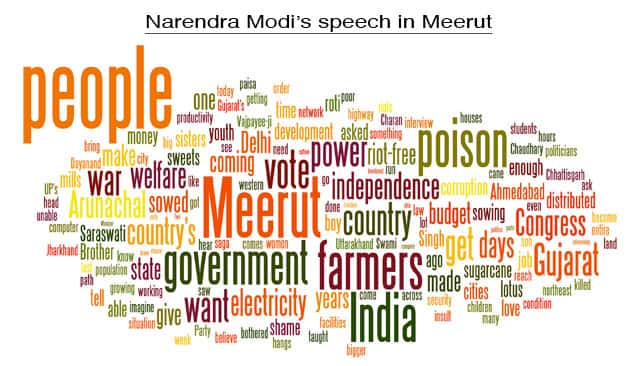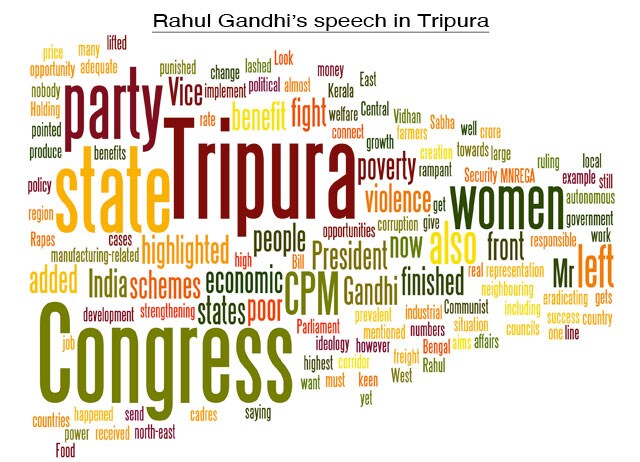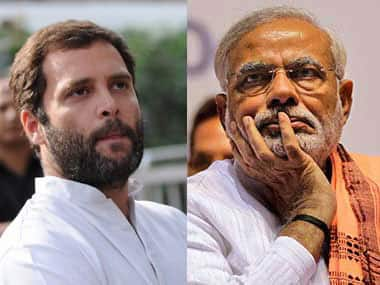A quick analysis of speeches by those in the fray for top jobs after Lok Sabha election 2014 will tell you just what are the subjects, areas of governance/ policy and assurances that they have spent some time thinking about.

 Speaking at Mandla, Madhya Pradesh, Congress vice-president Rahul Gandhi mentioned women six times, children once. In Ziro, Arunachal, he mentioned women five times, but skipped that mention entirely in his speech at Wangjing in Manipur, Tanda in Himachal Pradesh and Pratapgarh in UP. In several other speeches, women find mention two or three times. To be fair, the Congress vice-president, who spent several days in contemplation before agreeing to meet young Indians protesting on the streets of Delhi demanding better security for women in early 2013, has made some late attempts at speaking to that half of the electorate. India won’t progress without active and equal participation from its women, he has said. [caption id=“attachment_1455439” align=“alignleft” width=“380”]
Speaking at Mandla, Madhya Pradesh, Congress vice-president Rahul Gandhi mentioned women six times, children once. In Ziro, Arunachal, he mentioned women five times, but skipped that mention entirely in his speech at Wangjing in Manipur, Tanda in Himachal Pradesh and Pratapgarh in UP. In several other speeches, women find mention two or three times. To be fair, the Congress vice-president, who spent several days in contemplation before agreeing to meet young Indians protesting on the streets of Delhi demanding better security for women in early 2013, has made some late attempts at speaking to that half of the electorate. India won’t progress without active and equal participation from its women, he has said. [caption id=“attachment_1455439” align=“alignleft” width=“380”]
 Are both leaders failing to reach out to a crucial vote bank.[/caption] However, he has offered no concrete action plan on how to tackle sexual harassment at workplaces or domestic violence, nor any innovative measures for unorganised women workers, girls who drop out of school or women’s healthcare. No scheme for maternal mortality, infant mortality, no schemes to root out child marriage, no serious engagement on policing needs vis-a-vis rape/ sexual violence/ sexual harassment, stalking. Modi fares worse. In Kolkata, he mentioned women once, once in Delhi, skipped mention of them altogether in Varanasi and Meerut. At just a little less than half the electorate, you’d imagine women are utterly disenfranchised going by the frequency with which they find mention in the agenda around what is being pegged as the biggest milestone election in Indian history. Farmers, soldiers, businessmen, small businessmen, labourers, tribals, the impoverished, youth, chaiwallahs, rickshawallahs – all find more mention in the speeches of the average politician than the subject of gender. The Aam Aadmi Party has stated its commitment to the Left-drafted ‘womanifesto’ but Arvind Kejriwal too has failed to speak about his own ideas on gender issues facing India and Indian policy-makers.
Writing in The Times of India
, Arati R Jerath argues that this paradox – women as a rising force in elections, but an invisible half when manifestos are being drafted – results in a situation where political parties have a vague idea of the power of this 49 per cent of the electorate, but have little or no idea how to address them. “Can a free pressure cooker, for instance, tempt a woman to vote for A, B or C candidate or party? Or is she looking for measures that will substantially change her life by giving her economic freedom and rescuing her from abuse at home and rape at work? Has she earned the right to exercise independent voting choices in the 21st century? Or does she still remain a slave to the diktats of the men in her family and community?” she writes. It’s not as if women have not exercised their franchise. In 2009, of the total electorate of 71,69,85,101, 34,22,26,300 were women. That’s a percentage of 47.73 percent. Of the 41,71,59,281 votes polled, 19,10,28,997 were by women voters, a percentage of 45.79. While total polling percentage was 58.13 pc, the ratio of women who voted from among total women electors was 55.82 pc. The trend has been continuing from previous elections – women voters’ turnout as a percentage of total women voters remains consistently almost the same as the average turnout for men and women together. In 2004, the percentage of women who cast their vote to registered women voters was 53.64 – overall polling percentage was 58.07 percent. In 1999, 55.64 percent of women voters cast their vote, while total voting percentage was 59.99 pc. Every time, women have voted enthusiastically enough to almost match the total turnout percentage . In what is part symptom and part cause, not only have parties failed to address this vocal, voting half, they have also failed to build women’s wings that actively mobilise women voters. The Nationalist Congress Party, whose chief Sharad Pawar has been one of the more prominent champions of a 50 percent reservation demand for women in elected bodies in the country, set up the Rashtravadi Yuvati Congress to mobilise and train young women for a career in politics. But by and large women’s wings have remained mahila mandals, organising protests against such perceived “women’s issues” such as water shortages, in which participating women bring their rolling pins and plates.
Are both leaders failing to reach out to a crucial vote bank.[/caption] However, he has offered no concrete action plan on how to tackle sexual harassment at workplaces or domestic violence, nor any innovative measures for unorganised women workers, girls who drop out of school or women’s healthcare. No scheme for maternal mortality, infant mortality, no schemes to root out child marriage, no serious engagement on policing needs vis-a-vis rape/ sexual violence/ sexual harassment, stalking. Modi fares worse. In Kolkata, he mentioned women once, once in Delhi, skipped mention of them altogether in Varanasi and Meerut. At just a little less than half the electorate, you’d imagine women are utterly disenfranchised going by the frequency with which they find mention in the agenda around what is being pegged as the biggest milestone election in Indian history. Farmers, soldiers, businessmen, small businessmen, labourers, tribals, the impoverished, youth, chaiwallahs, rickshawallahs – all find more mention in the speeches of the average politician than the subject of gender. The Aam Aadmi Party has stated its commitment to the Left-drafted ‘womanifesto’ but Arvind Kejriwal too has failed to speak about his own ideas on gender issues facing India and Indian policy-makers.
Writing in The Times of India
, Arati R Jerath argues that this paradox – women as a rising force in elections, but an invisible half when manifestos are being drafted – results in a situation where political parties have a vague idea of the power of this 49 per cent of the electorate, but have little or no idea how to address them. “Can a free pressure cooker, for instance, tempt a woman to vote for A, B or C candidate or party? Or is she looking for measures that will substantially change her life by giving her economic freedom and rescuing her from abuse at home and rape at work? Has she earned the right to exercise independent voting choices in the 21st century? Or does she still remain a slave to the diktats of the men in her family and community?” she writes. It’s not as if women have not exercised their franchise. In 2009, of the total electorate of 71,69,85,101, 34,22,26,300 were women. That’s a percentage of 47.73 percent. Of the 41,71,59,281 votes polled, 19,10,28,997 were by women voters, a percentage of 45.79. While total polling percentage was 58.13 pc, the ratio of women who voted from among total women electors was 55.82 pc. The trend has been continuing from previous elections – women voters’ turnout as a percentage of total women voters remains consistently almost the same as the average turnout for men and women together. In 2004, the percentage of women who cast their vote to registered women voters was 53.64 – overall polling percentage was 58.07 percent. In 1999, 55.64 percent of women voters cast their vote, while total voting percentage was 59.99 pc. Every time, women have voted enthusiastically enough to almost match the total turnout percentage . In what is part symptom and part cause, not only have parties failed to address this vocal, voting half, they have also failed to build women’s wings that actively mobilise women voters. The Nationalist Congress Party, whose chief Sharad Pawar has been one of the more prominent champions of a 50 percent reservation demand for women in elected bodies in the country, set up the Rashtravadi Yuvati Congress to mobilise and train young women for a career in politics. But by and large women’s wings have remained mahila mandals, organising protests against such perceived “women’s issues” such as water shortages, in which participating women bring their rolling pins and plates.
Speech analysis: How Rahul, Modi are failing to target 49% of India's electorate
FP Politics
• March 28, 2014, 20:41:47 IST
Both Rahul and Modi only highlight a problem with most parties in India.
Advertisement
)
End of Article